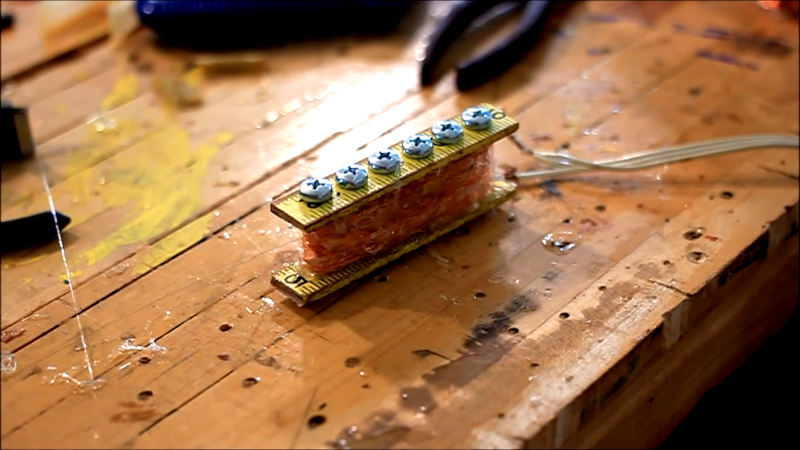Pickups are a key part of an electric guitar’s sound. You can spend a king’s ransom on tracking down just the right Vintage American Original 1950s Whatevers (TM) to put in your Spudocaster, but it’s not the only way. [Keith Decent] decided to make a pickup from scratch, using only materials found lying around the workshop. (Youtube, embedded below).
To build a pickup, you’ll want some magnet wire. In this case, [Keith] harvests this from an old transformer. A pickup body is then constructed from an old wooden ruler and some machine screws. A drill is used to spin the pickup body while the wire is roughly wound on, and everything is then held together with lashings of hot glue.
It’s a grungy build with a very Mad Max vibe – with the perfect aesthetic to suit [Keith]’s junkbox guitar build. The sound is good, but difficult to rate accurately when used on a guitar with slightly imperfect intonation. We’d love to hear it installed on a well-tuned body to get a better comparison.
It goes to show you don’t need to spend money on new parts and tools to get a build started. Sometimes you can make something perfectly functional with stuff you have lying around at home. Video after the break.















At minus 17 dB it was hard to hear (Audacity amplify) revealed a thin tone. There are usually lots of turns of fine wire, like the primary winding of the donor. As it stands it will be low impedance and need more gain than the classic pickup. The use of a magnet to hold the screws during assembly may not be enough to polarize the poles. You might try the touch of one of those hard drive magnets. If there is no magnetization of something it won’t make sound at all.
The abundance of dead toxic battery cordless drills make it possible to make a slow mounted winder jig out of one and wind with slow controlled payoff. Run it on an LM317 and set the speed as low as possible. You do not want to wind tight at any time during the wind. Pressure adds up and crushes the coating at whatever place a kink or bend happens at the corners.
I’m a ‘novice’ at the tech stuff – 60’s rocker. Play (fun/non professional) vintage ‘62 ES 345 stereo, varitone, bixby- best investment ever made (although, who knew in ‘62!). Would never screw with the Gibson but wonder if it is realistic to find pickup/s to install on a new mid quality acoustic that might come close providing the PAF beauty of the old 345? Want sound for American songbook (Gershwin/Bennet/Krall) but expand for Willy/country.
Grandpa Jim … (my grandkids love the oldies… Buddy, Beach Boys … even Larry Williams- remember him?).
++well done for the grungy build. Functionality and fun are important. Really neat builds are awesome too, but are out of my league and seem less attainable.
Building your own pickup is nice in case you want something with a custom string spacing or unusual number of strings. (a 9 string electric lap steel? sure why not)
You can also play with wire gauge and number of turns to get different impedance. Remember your vintage amp is only half of an electrical circuit, the other half is what’s in your guitar.
I love the paint roller tip for feeding wire! I’d recommend using some temporary spacers to keep the top and bottom parallel. I’m using black oxide screws for mine because I think they look nice (and seems ferric, not sure what kind of steel I bought)
Where do we get this magnet wire?
I’m guessing that you want copper wire
magnet wire = copper wire with enamel (or similar) insulation instead of PVC/silicone/etc..
RadioShack, Amazon, etc. It’s basicly enameled copper wire
Brian May’s seal of approval :-D
(The following message is tongue in cheek)
What! Somebody chopped up an antique folding ruler to make this!
Heresy!
I’m glad he didn’t have an old Edison cylinder phonograph, it would have been repurposed as a coil winder.
Also, that guy really likes his hot glue.
Actually, I can’t stand hot glue, but I didn’t have the time/patience to melt wax and coat it. Next time though!
How is it wired up is it just one on the copper ant the other one grounded
Yes, as you spotted, it’s an antenna. Ground is connected to the start of the coil (innermost) and signal is connected to the end of the coil (outermost).